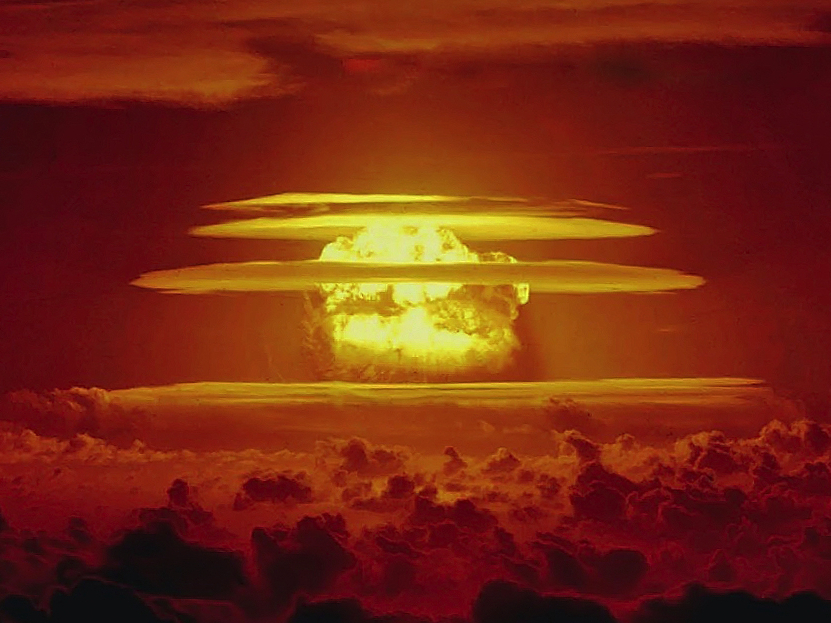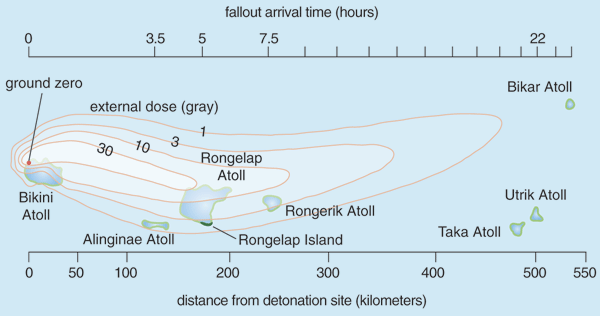Risks → War → Nuclear War → Radioactive Fallout
Oh Shit!

Castle Bravo nuclear detonation, Bikini Atoll, Marshall Islands, Pacific Ocean, March 1, 1954, yield 15 megatons
This was the largest US nuclear test and which spread dangerous fallout over 450 km contaminating numerous inhabited Pacific Islands
Source: US Department of Energy, See https://commons.wikimedia.org/wiki/Category:Castle_Bravo#/media/File:Castle_Bravo_nuclear_test_(cropped).jpg
Measuring Radiation
The becquerel (Bq) is the basic measure of radioactive activity viz., the number of radioactive atoms that are undergoing
decay/disintegration every second (or 1 count per second on a gieger counter). We also use the curie (Ci), for this measurement, where 1 curie = 37
Gigabecquerels (GBq) (37,000,000,000 Bq).
The different levels of radiation energy absorbed by any mass of material (the absorbed dose), including human tissue, is measured by the gray (
Gy) or rad where 1 gray = 100 rad.
The standard metric unit for measuring biological damage to the human body from radiation (the equivalent or effective dose)
is the sievert (Sv) where 1 Sv = 1,000 millisieverts (mSv) = 1,000,000 microsieverts (μSv). USA uses the rem for this measurement
where 1 sievert = 100 rem.
Radioactive Fallout
Fallout is the debris and radioactive particles that fall back to earth after a nuclear explosion. It will comprise weapon debris, fission products, and,
if the explosion occurs at ground level, radiated soil that has been sucked up into the explosive fireball. For explosions
with yields of 100 kilotons or less, the fireball does not rise above
the lower atmosphere so fallout will be rapid (minutes) and localised. For explosions in the high kiloton to megaton range the resulting isotopes rise
much higher into the atmosphere (stratosphere) and can be carried many kilometres and take time (hours - days - months - years) before they return to earth.
Perhaps the most important factors in controlling fallout are the height of detonation and prevailing weather conditions at the time of explosion.
Air burst explosions will produce little fallout, while surface bursts large amounts.
Fallout, when present will be predominantly downwind, the stronger the wind the further it travels. Heavy rain will also intensify fallout locally.
Common Radioactive Elements in Fallout
Debris produced from fission reactions creates large numbers of radioactive isotopes. Over 300 fission products are known. These isotopes vary considerably in stability. Some undergo decay in seconds (short-lived), while others take many years to decay (long-lived). The more common long lived radioactive isotopes, and those that contribute significantly to fallout, are tabulated below:
| Isotope | Half Life | Dangers |
|---|---|---|
| Iodine 131 | 8.1 days | Concentrates in and destroys thyroid gland. |
| Tritium | 12.3 years | Easily ingested as it can replace hydrogen in water, Can cause lung cancer. |
| Strontium 90 | 28 years | Accumulates in growing bones. Can cause tumors, leukemia and other blood anomalies. |
| Cesium 137 | 30 years | Can contribute to genetc damage |
| Plutonium 239 | 24,400 years | Highly poisonous. Forms bone and lung tumours. |
These long-lived isotopes are particularly concerning. For the survivors of a nuclear war, this lingering radiation hazard may represent a threat for many years after an attack. In general, however, the threat from nuclear fallout will reduce over time due to radioactive decay. Fallout comprising mostly short lived isotopes will be highly dangerous initially, but will usually disperse usually within hours.

Map of fallout from the Castle Bravo nuclear detonation, Marshall Islands, March 1, 1954
Source: American Scientist, See: https://www.americanscientist.org/article/fallout-from-nuclear-weapons-tests-and-cancer-risks
Radiation Doses and Effect on Humans
The higher the cumulative radiation dose, the greater will be the threat to human health. A total dose of 2,000 millisieverts (mSv) or higher will induce acute radiation sickness. A total dose of 10,000 mSV will probably be fatal within days. At moderate total doses, 100 to 1,000 mSv the risk of cancer, particularly in later life, becomes significant. Below 100 mSv the effects from radiation exposure will be negligible.
Principle human organs that are effected by radiation are eyes, thyroid, lungs, stomach, reproductive organs, skin and bone marrow.

Radiation effects on the human body
Source: ResearchGate, See: https://www.researchgate.net/figure/Radiation-Level-and-its-Effect-on-Human-Body_fig3_361279453